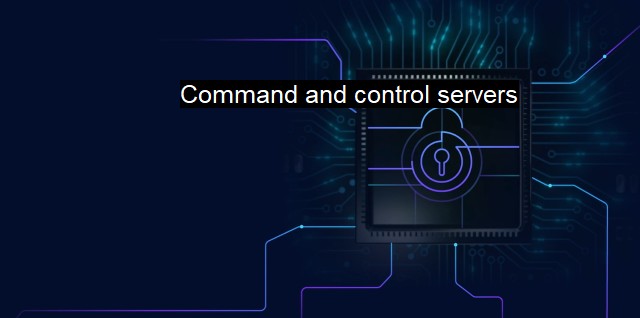What are Command and control servers?
The Integral Role of Command and Control (C&C) Servers in Cyberattacks: Communication Centres and Botnet Control through Advanced Protocol Evolution
Command and Control Servers, often abbreviated as C&C or C2 servers within the cybersecurity and antivirus domain, play a pivotal role in initiating and commanding cyber-attacks. Designed to run automated tasks over controlled systems remotely, C&C servers have established an ominous presence in the world of cybercrime. Often in conjunction with botnets, malware, or ransomware, C&C servers continuously pose significant challenges and threats to individual or corporate cybersecurity landscapes across the globe.Understanding the working principle of C&C servers facilitates a more nuanced comprehension of the cyber threats in today's digital-first world. Interestingly, the foundation of a command and control server lies in its innate deception. Cybercriminals, or hackers, use these servers to dispatch orders to systems compromised by a malicious software, known as bots. Fundamentally, a command and control server is the central node of an extensive network of infected computers or bots, aptly termed a 'botnet.'
A hacker gains remote access to computers through the unassuming method of infiltrating these systems with malicious software. The actual deployment of malware can take place through the most benign-looking email attachments, downloadable files, or system vulnerabilities. Once the malware intrusion successfully occurs, it transforms the infected computer into a 'bot.' Concealed from the system owner's awareness, this bot begins communication with the C&C server without raising alarm bells.
The symbiotic relationship between these bots and the C&C server results in the formation of the aforementioned botnet. Commanding mission-critical processes, the C&C server can direct bots to retrieve specific system information, download additional malware, or even dispatch spam. In more severe incidents, C&C servers also orchestrate Distributed Denial of Service attacks, wherein bots flood targeted systems, causing their collapse under the load.
These practices reaffirm the C&C servers' administrative mandates and incursive operations, certifying their emergent threat to cybersecurity norms. Time-sensitive action against ransomware attacks or system intrusions necessitates efficient, anticipative Command and Control Server defenses in modern cybersecurity strategies. With this understanding, antivirus software providers and cybersecurity experts worldwide actively develop and deploy defenses to detect, restrict, and eliminate bots to reduce the control of C&C servers.
One of the initial defense barriers includes the implementation of strong antivirus software. Antivirus software contains the capabilities to scan, identify, and mitigate potential malicious software applications. Behavioral analytics feature as one of the robust tools in the antivirus arsenal against malware. As the term signifies, the software analyzes software behavior on systems and then compares these behaviors with known patterns of malware, flagging any suspicious activities that correspond.
To supplement antivirus defense, organizations embrace additional measures like application white listing, patch management, and regular system updates. the use of advanced threat intelligence services enriches these defenses enabling more robust identification, classification and blocking of C&C server activities. This collective multi-tiered defense against C&C servers underpins a healthier and more secure cyber ecosystem.
Command and Control Servers form the backbone of an expansive, sophisticated network of compromised systems, often operating beyond the detection of unaided human perception. As cyber-attacks evolve and increase in frequency and sophistication, cybersecurity defenses' battle against these inimical C&C servers is perpetually evolving. Despite such advancements, the importance of user-level awareness about common infiltration techniques of these servers remains essential to preclude any opportunity of system compromise, thus fortifying front-line defenses against cybersecurity threats.

Command and control servers FAQs
What are command and control servers in cybersecurity?
Command and control servers are computer systems that have been compromised by cybercriminals to remotely manage malware that has been placed on other computers. These servers allow cybercriminals to control a network of infected devices and steal sensitive data or use the compromised devices for malicious activities.How do command and control servers work?
Command and control servers work by establishing a connection between the server and the compromised devices through the malware installed on them. The malware sends information about the infected device back to the server and receives commands from the server. This allows the cybercriminal to remotely manage the infected devices and use them for their malicious activities.What is the significance of command and control servers in antivirus software?
Antivirus software identifies command and control servers as a threat vector and works to prevent the malicious traffic from communicating with the server. Once the C&C server is identified, the antivirus software blocks its use, making it difficult for cybercriminals to carry out their activities.How can organizations protect themselves from command and control servers?
Organizations can protect themselves from command and control servers by implementing security measures such as firewalls, intrusion detection systems, and antivirus software. Additionally, staying vigilant and educating employees about potential security threats and safer browsing habits can also be effective in preventing these attacks.| | A | | | B | | | C | | | D | | | E | | | F | | | G | | | H | | | I | | | J | | | K | | | L | | | M | |
| | N | | | O | | | P | | | Q | | | R | | | S | | | T | | | U | | | V | | | W | | | X | | | Y | | | Z | |
| | 1 | | | 2 | | | 3 | | | 4 | | | 7 | | | 8 | | |||||||